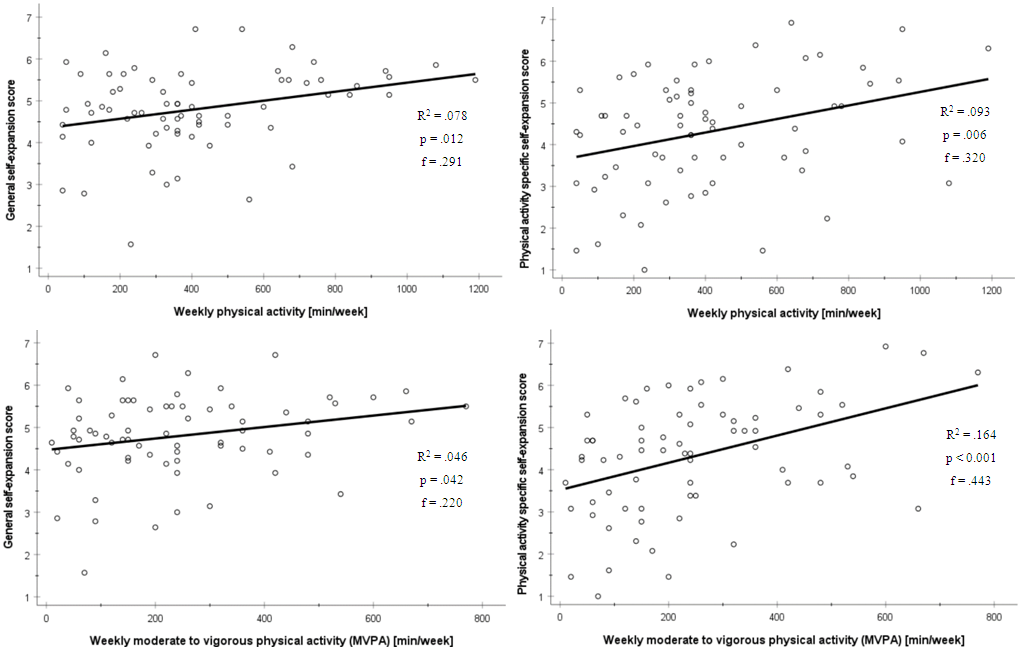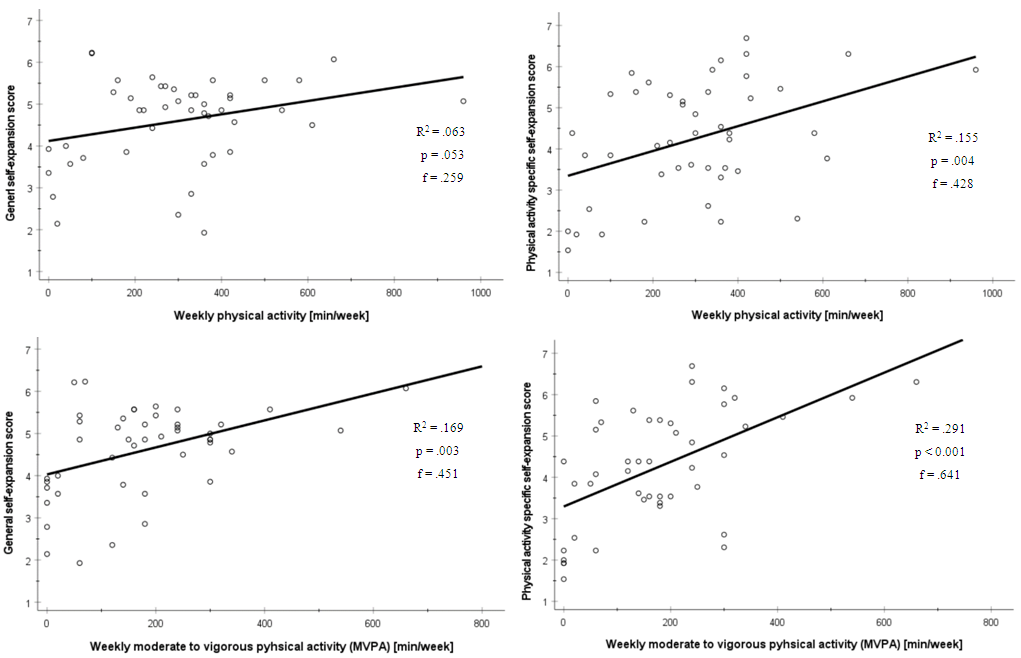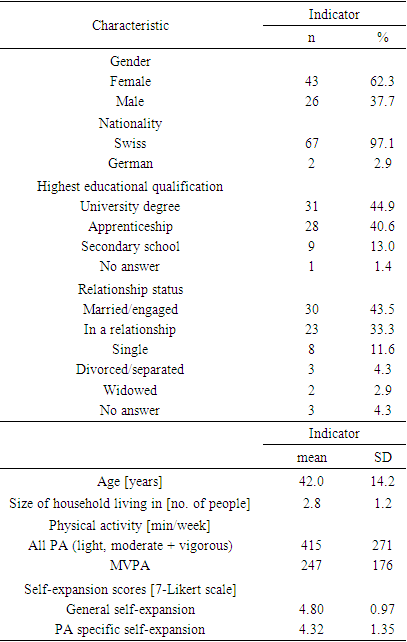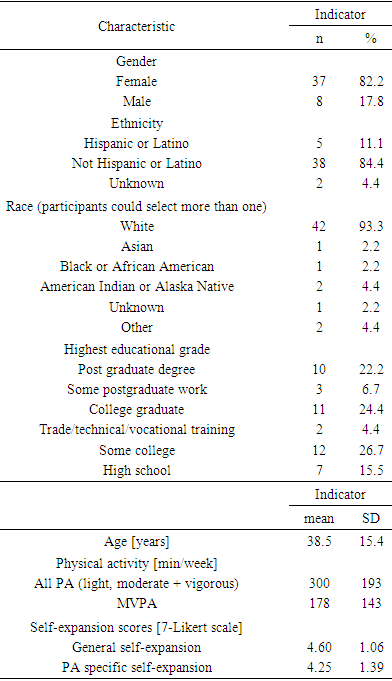-
Paper Information
- Paper Submission
-
Journal Information
- About This Journal
- Editorial Board
- Current Issue
- Archive
- Author Guidelines
- Contact Us
International Journal of Applied Psychology
p-ISSN: 2168-5010 e-ISSN: 2168-5029
2023; 13(1): 9-17
doi:10.5923/j.ijap.20231301.02
Received: Apr. 10, 2023; Accepted: May 15, 2023; Published: May 29, 2023

The Relationship between Self-Expansion and Physical Activity in Rural Adults in Bern, Switzerland and Idaho, USA
Claudio R. Nigg 1, Benjamin Dütschler 1, Sandra Schnegg 1, Joseph Do 2, Xiaomeng Xu 2
1Health Science Department, Institute of Sport Science, University of Bern, Bern, Switzerland
2Psychology Department, Idaho State University, Idaho, USA
Correspondence to: Claudio R. Nigg , Health Science Department, Institute of Sport Science, University of Bern, Bern, Switzerland.
| Email: |  |
Copyright © 2023 The Author(s). Published by Scientific & Academic Publishing.
This work is licensed under the Creative Commons Attribution International License (CC BY).
http://creativecommons.org/licenses/by/4.0/

Self-expansion theory posits that people are motivated to pursue activities that expand one’s efficacy and ability to accomplish goals. Self-expanding activities are associated with positive health behaviours including physical activity (PA). However, research to-date on self-expansion and PA has involved only urban samples within the USA. The objective of this cross-sectional study was to extend current knowledge by investigating the connection between self-expansion and self-reported PA levels in two independent rural samples, one in Bern, Switzerland (n=69) and one in Idaho, USA (n=45). Participants were adults’ (≥18 years old) who completed online measures of PA, general self-expansion, and PA specific self-expansion. Both samples showed similar results and confirmed the hypotheses that self-expansion is positively related to PA; and that PA specific self-expansion exhibits a stronger relationship to PA compared to general self-expansion. Effect sizes with Cohen’s f ranged from 0.220 to 0.443 in the Bernese sample and 0.451 to 0.641 in the Idaho sample. Effects were even stronger for moderate to vigorous physical activity (MVPA) and general self-expansion as well as PA specific self-expansion and MVPA with this relationship having the strongest effect for both independent samples. These two studies provide evidence that there is a medium to large relationship between self-expansion and PA. Future research including longitudinal and intervention studies and studies with larger samples in multiple countries are needed to test directionality of influence and whether leveraging existing intrinsic motivation via self-expansion could offer a novel approach to promoting PA.
Keywords: Self-expansion, Physical activity, Cross-cultural, Theory
Cite this paper: Claudio R. Nigg , Benjamin Dütschler , Sandra Schnegg , Joseph Do , Xiaomeng Xu , The Relationship between Self-Expansion and Physical Activity in Rural Adults in Bern, Switzerland and Idaho, USA, International Journal of Applied Psychology, Vol. 13 No. 1, 2023, pp. 9-17. doi: 10.5923/j.ijap.20231301.02.
Article Outline
1. Introduction
- Benefits of physical activityPhysical activity (PA) has numerous positive effects on mental and physical health (Warburton et al., 2006) including improving quality of life (Marquez et al., 2020; Penedo & Dahn, 2005), playing a protective role in depression (Ströhle, 2009) and cognitive decline (Sofi et al., 2011), and extending life expectancy (Arem et al., 2015; Gebel et al., 2015; Wen et al., 2011). Physical inactivity leads to a higher risk for many non-communicable diseases (NCDs) such as diabetes, cardiovascular diseases, hypertension, obesity and even some types of cancer (American Cancer Society, 2020; Lee et al., 2012; National Cancer Institute, 2020; Sattelmair et al., 2011; Swift et al., 2013), while higher levels of PA are consistently associated with reduced risk for NCDs and healthier body composition, blood pressure, and cholesterol levels (Warburton et al., 2006). Despite these PA benefits, the physical inactivity prevalence is growing worryingly, with over a quarter (27.5%) of the world's population not meeting the WHO PA guidelines of 150 min/week of moderate to vigorous PA (Guthold et al., 2018). Therefore, new approaches are urgently needed to increase PA.Self-ExpansionOne potentially promising avenue to increase PA is by leveraging existing intrinsic motivation via self-expansion. The self-expansion model (Aron & Aron, 1986; Aron et al., 2013) states that individuals are motivated to pursue activities that expand their efficacy and ability to accomplish goals. That is, people will seek out experiences that feature novelty, excitement, interest, and/or challenge (e.g., engaging in hobbies, social activities, and intellectual pursuits). These experiences allow individuals to add positive content to their self-concept by increasing perspectives, identities, and resources. Self-expansion is rooted in approach motivation (Mattingly et al., 2012) and positively influences motivation, effort, and persistence (Aron et al., 2002; Mattingly & Lewandowski, 2013), suggesting that self-expansion can address some of the barriers (e.g., low motivation, low enjoyment, low self-efficacy, high perceived effort) to behavioural change and maintenance.Translational work utilizing self-expansion theory within the health field (see Xu, 2020 for review) has shown that self-expansion is associated with more successful quit attempts among smokers (Xu et al., 2010), attenuates cigarette cue-reactivity in the brain (Xu et al., 2014), and is associated with better weight loss intervention outcomes (Xu et al., 2017). In terms of PA, self-expansion has been proposed as a factor to consider in exercise prescriptions for adults (Strohacker et al., 2015), and there is evidence that self-expansion is positively associated with both self-report PA (Xu et al., 2017) and objectively measured PA using Fitbit monitors (Xu et al., 2021). However, to date all research of PA and self-expansion has focused on urban samples in the USA.Rural vs. urban PAIn the USA, rural populations are less likely to meet PA guidelines compared to urban and suburban populations (Matthews et al., 2017; Trivedi et al., 2015), particularly in terms of high-intensity PA (Fan et al., 2014). Rural disparities in PA are especially notable as rural populations are already disproportionately affected by health issues such as greater premature mortality (before age 75) and higher death rates from chronic obstructive pulmonary disease, diabetes, cardiovascular disease, coronary heart disease, cancer, and stroke (Anderson et al., 2015; Callaghan et al., 2017; Eberhardt & Pamuk, 2004; Kulshreshtha et al., 2014). Rural residents also exhibit higher rates of chronic illnesses including diabetes and hypertension (Eberhardt & Pamuk, 2004; O’Connor & Wellenius, 2012) and rural areas face disparities of resources.Several different methods exist to address disparities in PA. However, a recent meta-analysis of 12 rural intervention studies (Cleland et al., 2017) found that overall “there was no effect of the interventions on physical activity” (p. 735), highlighting the need for research into novel approaches. Mixed data show lower PA prevalence in rural versus urban Switzerland (Swiss Health Observatory, 2021), however, Lamprecht et al. (2020) report no difference exists in the amount of physical activity between rural and urban areas in Switzerland. However, differences exist in sport motives and the setting in which people are physically active. In rural Swiss regions people tend to be more physically active for social reasons and to be in the nature while in urban regions figure and appearance, relaxation and stress relief are stronger sport motives. In the rural Swiss regions people do sports mostly in a sports club while in urban Swiss regions more people do their exercise in a gym (Lamprecht et al., 2020). Currently there is little research on the relationship between self-expansion and PA, with no research in rural populations or in non-USA populations. This is important in order to establish generalizability of the self-expansion concept for PA, with related intervention implications. Therefore, the purpose of this study was to identify the relationship of general self-expansion and PA specific self-expansion with PA in rural adults, drawing from two countries to explore robustness of the relationships cross-culturally. Based on previous self-expansion and PA literature it was hypothesized that there would be a positive relationship of self-expansion with PA with behaviour specific self-expansion exhibiting a stronger relationship versus general self-expansion.
2. Methods
- DesignThe study is a cross-sectional online survey with two independent samples (rural Bernese sample and rural Idaho sample). Participants in both samples had to be at least 18 years old and live in either rural aeras of the canton of Bern, in Switzerland or rural areas of the state of Idaho, USA, both defined as towns having less than 50,000 inhabitants. The study was approved by the Ethics Commission of the Faculty of Human Sciences at the University of Bern (Nr. 2020-09-00001) and by the Human Subjects Committee of Idaho State University (IRB-FY2020-288).Recruitment strategy for the rural Bernese sampleTo enhance participation, the materials including the recruitment flyer were developed in German (the lack of resources did not allow for translating the materials to French). The flyer consisted of information regarding the topic of the study, the investigators, and which requirements the participants must meet. The recruitment phase lasted one month, from 19th of October until the 19th of November 2020. In an internet search, E-Mail contacts from churches, municipalities, pharmacies, and associations of all towns German speaking towns in the canton of Bern were contacted and asked to hang up or disseminate our flyer. In total 1326 contacts received the recruitment request (678 associations, 283 municipalities, 92 pharmacies, 273 churches). Seventy-one contacts replied to the request, 33 reacted negative (e.g., no bulletin board at the moment, because of the Corona virus) and 38 positive (e.g., we have hung the flyer up). Meanwhile the study was featured on the website of the University of Bern with the call for study participation. To reach more participants, a Facebook account was created and the flyer including the link to the questionnaire was posted in different active Facebook groups from different rural Bernese towns. In addition, flyers were hung up in rural supermarkets.Recruitment strategy for the rural Idaho sampleRecruitment in Idaho occurred in two phases. The initial data collection phase lasted one month from the 26th of June until the 26th of July 2020, and a second data collection phase lasted from the 4th of February to the 14th of March 2021. Recruitment occurred through social media posts, flyers, and word of mouth. The flyers included a QR code and URL to the study site and information on the study including compensation (entry into raffles for two $25 gift cards). Flyers were placed in public spaces (e.g., coffee shops) in the rural counties surrounding the institution. Flyers were also emailed to 120 libraries in rural areas of Idaho with a request that they be posted on bulletin boards. MeasuresAfter completing informed written consent, participants accessed an online questionnaire form (limesurvey.org for Bern and Qualtrics.com for Idaho) which included an adapted version of the Godin-Shepard leisure time physical activity questionnaire (Godin & Shephard, 1985), a general self-expansion questionnaire, a physical activity specific self-expansion questionnaire, and demographics (see Tables 1 and 2).Physical activity measuresTo assess the leisure-time physical activity (LTPA) an adapted version (Nigg et al., 2021; Fleary et al., 2017) of the Godin-Shepard leisure time physical activity questionnaire (GSLTPAC, Godin & Shephard, 1985) was used. This questionnaire was developed by Godin and Shepard in 1985 to identify the leisure-time physical activities during a typical 7-day period and is self-reported (Sari & Erdoğan, 2016). The GSLTPAC has documented validity for across the lifespan (Amireault & Godin, 2015; Schumann et al., 2002; Schumann et al., 2003). Number of days per week and the number of hours in which light, moderate or vigorous physical activity was performed are assessed. Light activity is classified as activities which are not exhausting and do not make you sweat such as light walking or golfing. Moderate activity is classified as activities which make you sweat a little but do not exhaust you such as fast walking or moderate swimming. Vigorous activities make your heart beat faster and make you sweat such as football (soccer) or skiing. Additionally, participants were asked how many minutes they spent with sedentary behaviour during the past seven days.Self-expansion measuresGeneral self-expansion and PA specific self-expansion were assessed with modified versions of the Self Expansion Questionnaire (SEQ; Lewandowski & Aron, 2002), which is the first and most used measure of self-expansion (e.g., Mattingly et al., 2012). The SEQ consists of 14-items with a 1 (not very much) to 7 (very much) Likert-type response scale. Because the original SEQ focuses on self-expansion within romantic relationships with all questions about the partner or relationship, we used a modified version of the measure so that all items were appropriate for our samples. For example, the item “Do you often learn new things about your partner?” was modified to “Do you often learn new things?” We also used a PA specific modified SEQ consisting of 13 items with a 1 (not very much) to 7 (very much) Likert-type response scale. For example, the item “Do you often learn new things about your partner?” was modified to “Do you often learn new things about physical activity?”. Instructions for both general self-expansion and PA specific self-expansion measures were also modified such that participants were asked to respond based on a typical 7-day period; this was done so that the timeframe of the SE measures was congruent with the PA measure. Both surveys are available in their disseminated language as supplemental material.Statistical analysisIBM SPSS version 27.0 was used for all statistical calculations. Alpha level was set at α = .05. Cronbach’s alpha (Cortina, 1993) was calculated for internal consistency of the SEQ and the PA SEQ. To calculate self-reported weekly PA minutes “more than 60 mins of PA per day” was conservatively transformed to 60 min per day. Weekly activity levels for moderate to vigorous physical activity (MVPA) and total PA levels (light, moderate and vigorous) were then calculated by multiplying the number of days per week spent with each PA intensity by the corresponding duration. A linear regression model was used to investigate how weekly PA and the self-expansion scales are connected.Mann-Whitney-U-Tests were calculated for comparison of the general and PA specific self-expansion values as well as PA and MVPA between the two rural samples. To compare the correlation coefficients between the independent rural Bern and rural Idaho sample, Fisher-Z-transformation of correlations and a comparison of these Z values was calculated (Eid et al., 2011, pp. 547).
3. Results
- Results from rural BernAlmost 50% (76/156) of people that followed the link to the survey completed it. Seven questionnaires’ postal code was not from a rural area, or they did not complete the attention control question “Answer this question with number 4” correctly, thus were excluded from analyses. No missing data was amongst the remaining 69 Swiss participant’s surveys. The majority (62.3%) of the rural Bern participants were female, about 42 years old, and mainly of Swiss nationality (for detailed demographics see Table 1). Swiss participants reported 415 minutes per week [SD=271] of PA of which 247 minutes per week [SD=176] were MVPA.
|
 | Figure 1. Scatterplots with adjusted R2 and Cohen’s f for effect sizes for self-expansion and physical activity for the rural Bernese sample (n=69) |
|
 | Figure 2. Scatterplots with adjusted R2 and Cohen’s f for effect sizes for self-expansion and physical activity for the rural Idaho sample (n=45) |
4. Discussion
- This project investigated the relationship between self-expansion and PA specific self-expansion with PA in rural adults from two regions in western countries (Switzerland and the USA). The hypotheses were confirmed in both samples: 1) that self-expansion is positively related to PA; and 2) that PA specific self-expansion exhibits a stronger relationship to PA compared to general self-expansion. All relationships were in the medium to strong effect size range. For both rural samples, the strongest correlations were found between the PA specific self-expansion and MVPA. People with higher levels of MVPA generally had higher levels of self-expansion, especially higher PA specific self-expansion, while people who were less physically active reported lower self-expansion. This finding suggests that there could be a possible dose response relationship between PA and self-expansion. Future research is needed to test for this possible dose effect and investigate if it is similar to the dose response relationships that exist for health outcomes of PA (Kesaniemi et al., 2001).Although rural Bern and rural Idaho are areas in two different western countries with differences in demographics and culture, the similar results from our two independent samples suggest that the relationship between self-expansion (especially PA specific self-expansion) and PA may be generalizable. Future studies are needed with larger and more diverse samples, including non-western cultures, to determine the generalizability of this relationship.The potential implication that these findings indicate is that self-expansion, especially domain specific self-expansion, may be useful in further understanding why people adopt and maintain PA. Further investigation is recommended investigating the concepts and underlying mechanisms of novelty, excitement, interest, and/or challenge in promoting PA. These concepts are largely not included in the most frequently used theories in the PA area (e.g., see Symons Downs et al., 2014), thus may expand our understanding. Such investigations may point to novel and personally relevant ways of approaching and motivating individuals to incorporate PA into their lives.The two studies in this project are not without limitations. First, the studies utilized a cross-sectional design which does not allow for conclusions about directionality of influence (self-expansion leading to MVPA or vice versa) or causal inferences. Future longitudinal and experimental studies are needed to clarify directionality and causality. Second, the current samples self-reported nearly double the recommended levels of MVPA. Future research is needed to elucidate whether the relationships found in the current samples generalize to less active or sedentary samples. Finally, online recruitment and the use of self-report assessments may have introduced self-selection and social desirability reporting biases. While previous research utilizing device-based PA measures have also found the self-expansion and PA effect (Xu et al., 2021), additional studies employing device-based PA measures are needed to verify the findings of the current project in rural areas.The current research represents the first studies to investigate self-expansion and PA in rural samples, and the first research to investigate this relationship outside the USA. The results of these two studies are in line with previous research with urban USA samples showing that self-expansion is positively associated with PA. In addition to replicating past effects, the current project provides new evidence on the relationship between self-expansion and levels of PA as well as the importance of domain specificity (PA specific self-expansion). These results suggest that the self-expansion and PA relationship, particularly for MVPA and PA specific self-expansion, may be robust, generalizable, and an appropriate target for future research on PA promotion.
ACKNOWLEDGEMENTS
- We would like to thank all participants of this study and Timo M. O. Felder and Patrick T. Zimmermann for helping with the recruitment in Bern, Switzerland.
Funding Details
- No funding was received for this study.
Declaration of Interest Statement
- The authors have no conflict of interests to declare.
Data Availability Statement
- The data that support the findings of this study are available from the corresponding author, [CN], upon reasonable request.
 Abstract
Abstract Reference
Reference Full-Text PDF
Full-Text PDF Full-text HTML
Full-text HTML
